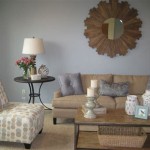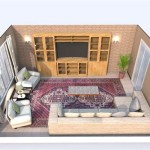How To Add Color To Living Room
The living room, often considered the heart of the home, serves as a central space for relaxation, entertainment, and social gatherings. A well-designed living room reflects the homeowner's personality and style, and color plays a crucial role in establishing the desired ambiance. Introducing color effectively can transform a dull or uninspired living room into a vibrant and inviting space. This article explores several strategies for incorporating color into a living room, considering various elements and techniques to achieve a balanced and visually appealing result.
Before embarking on a color transformation, it's important to assess the existing conditions. Consider the natural light available in the room, the size of the space, and any existing architectural features. A room with limited natural light might benefit from lighter, brighter colors, while a larger room can accommodate bolder, more saturated hues. Existing furniture and flooring also influence color choices, as the new additions should complement or contrast them in a harmonious manner. Understanding these factors lays the foundation for making informed decisions about color implementation.
Selecting a Color Palette
The foundation of any successful color scheme lies in selecting a well-coordinated palette. There are several approaches to palette selection, each offering a distinct aesthetic. Monochromatic schemes rely on variations of a single color, creating a sense of unity and sophistication. Analogous schemes utilize colors that are adjacent to each other on the color wheel, resulting in a harmonious and visually pleasing arrangement. Complementary schemes pair colors that are opposite each other on the color wheel, generating a dynamic and vibrant contrast. Triadic schemes employ three colors that are evenly spaced on the color wheel, offering a balanced and visually engaging composition. Understanding these color relationships allows for the creation of a palette that reflects the desired mood and style.
Consider the psychological effects of different colors when choosing a palette. Blues and greens often evoke feelings of tranquility and serenity, making them suitable for creating a relaxing atmosphere. Yellows and oranges are associated with warmth and energy, ideal for brightening up a space and fostering a sense of optimism. Reds and purples can add drama and sophistication, but should be used with caution as they can be overwhelming in large doses. Neutrals, such as grays, whites, and beiges, provide a versatile backdrop that can be accented with pops of color. Careful consideration of the emotional impact of each color ensures the living room reflects the desired feelings and experiences.
Once a general color scheme is selected, it is helpful to gather physical samples, such as paint chips, fabric swatches, and color cards. These samples allow for visual assessment under different lighting conditions and help ensure that the chosen colors complement each other effectively. It is also advisable to test paint colors on a small area of the wall before committing to the entire room. This allows for a realistic evaluation of the color's appearance and its interaction with the existing environment. Consider painting large swatches (at least 2 feet by 2 feet) and observing them at different times of day to account for changes in natural light.
Applying Color Through Walls
The walls represent the largest surface area in a living room, making them a primary vehicle for introducing color. Painting the walls is a cost-effective and straightforward way to dramatically transform the space. When selecting a wall color, consider the size and shape of the room. Lighter colors tend to make a room feel larger and more open, while darker colors can create a sense of intimacy and coziness. In a smaller room, it may be best to stick with lighter hues, while a larger room can handle bolder, more saturated colors.
An accent wall can be a striking way to introduce a pop of color without overwhelming the entire room. An accent wall is typically a single wall painted in a different color than the other walls, drawing attention and creating a focal point. Common choices for accent walls include the wall behind a sofa, the wall with a fireplace, or a wall with interesting architectural details. The color of the accent wall should complement the other colors in the room and contribute to the overall aesthetic. Wallpaper is another option for adding color and texture to the walls. Wallpaper comes in a vast array of patterns, colors, and textures, allowing for a wide range of design possibilities. It can be used to create a statement wall, to add visual interest to a small space, or to create a cohesive look throughout the room.
Beyond solid paint colors and wallpaper, there are various decorative painting techniques that can add depth and interest to the walls. Techniques such as stenciling, sponging, and color washing can create subtle textures and patterns, adding visual complexity to the room. These techniques can be used to create a more unique and personalized look. Consider consulting with a professional painter to explore different decorative painting options and ensure a high-quality finish.
Incorporating Color Through Furniture and Accessories
Furniture and accessories offer a flexible and easily changeable way to introduce color into a living room. Unlike painting walls, which can be a more permanent commitment, incorporating color through furniture and accessories allows for greater experimentation and easy adjustments over time. A brightly colored sofa or armchair can serve as a focal point in the room, adding a bold statement and injecting personality. Consider opting for furniture in a vibrant color that complements the overall color scheme. Alternatively, neutral-colored furniture can be accessorized with colorful cushions, throws, and rugs.
Colorful cushions and throws are a simple and affordable way to add pops of color to a living room. These accessories can be easily swapped out to change the look of the room with the seasons or to reflect personal preferences. Choose cushions and throws in a variety of colors, patterns, and textures to create a visually interesting and inviting space. Rugs are another effective way to introduce color and define different areas within the living room. A brightly colored rug can anchor a seating area and add warmth and texture to the space. Choose a rug that complements the overall color scheme and ties together the various elements in the room.
Artwork and decorative objects provide opportunities to introduce color and personalize the living room. Choose artwork that features colors that complement the overall color scheme and reflects personal tastes. Decorative objects, such as vases, sculptures, and candles, can also be used to add pops of color and visual interest to the room. Plants are another excellent way to introduce color and texture, bringing a touch of nature indoors. Greenery can add a refreshing and calming element to the living room, complementing the other colors in the space.
Balancing Color and Neutrality
While incorporating color is essential for creating a vibrant and engaging living room, it is equally important to strike a balance between color and neutrality. Overusing color can lead to a visually overwhelming and chaotic space. Neutral colors provide a calming backdrop that allows the accent colors to shine. A good rule of thumb is to follow the 60-30-10 rule: 60% of the room should be the dominant color (typically a neutral), 30% should be a secondary color, and 10% should be an accent color. This approach ensures a balanced and harmonious color scheme.
Neutrals don't have to be boring. There is a wide range of neutral colors, from warm beiges and creams to cool grays and whites. Each neutral color has its own unique character and can be used to create different moods. Warm neutrals create a cozy and inviting atmosphere, while cool neutrals create a more modern and sophisticated look. Consider the existing elements in the room, such as flooring and furniture, when choosing a neutral color. The neutral should complement these elements and provide a cohesive backdrop for the accent colors.
Texture plays a crucial role in adding visual interest to a neutral space. Incorporate textures such as wood, stone, and fabric to create depth and dimension. A textured rug, a woven throw, or a wooden coffee table can add warmth and character to a neutral living room. Metallic accents, such as gold or silver, can also add a touch of glamour and sophistication. A metallic lamp, a mirror with a metallic frame, or decorative objects with metallic finishes can elevate the look of the room.
Lighting is a key factor in how colors appear in a space. Natural light enhances the vibrancy of colors, while artificial light can alter their appearance. Consider the type of lighting in the living room when choosing colors. Incandescent lighting tends to cast a warm, yellow glow, while fluorescent lighting tends to cast a cooler, blue glow. LED lighting offers a more neutral light that accurately reflects colors. Experiment with different lighting options to see how they affect the colors in the room and adjust the color scheme accordingly.

How To Add Pops Of Color A Neutral Space Worthing Court

How To Add Color Your Home Without Painting Interiors Camphill Lancaster York Pa Furniture Store

How To Add Color Your Living Room Without Committing

How To Add A Splash Of Color Your Neutral Living Room Snow Globe

How To Add Colour A Beige Living Room With Art Inspiration
How To Add Color Your Home According Interior Designers Business Insider

Neutral Living Room How To Add Color Your Space

How To Add Colour A Beige Living Room With Art Inspiration

How To Add Color A Room No Matter What Your Palette Is

20 Ways To Add Color Your Home Without Painting Foyr








